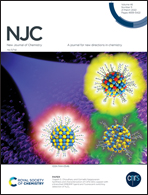Non-salen coumarin Schiff base chiral fluorescent probe turn on circularly polarized luminescence by Mg2+ and Zn2+†
Abstract
In this work, we designed two non-salen coumarin Schiff base chiral fluorescent probes 3,3′-((1E,1′E)-(((1,2)-cyclohexane-1,2-diyl)bis(azaneylylidene))bis(methaneylylidene))bis(7-methoxy-2H-chromen-2-one) (L1) and 3,3′-((1E,1′E)-(((1,2)-cyclohexane-1,2-diyl)bis(azaneylylidene))bis-(methaneylylidene))bis(2H-chromen-2-one) (L2), which have outstanding circular dichroic CD signals but almost show no circularly polarized luminescence (CPL) signals. By adding metal ions that can effectively inhibit photo-induced electron transfer (PET), it was observed that L1 can be used as a highly sensitive dual detection ion probe for Mg2+ and Zn2+ as Mg2+ and Zn2+ can turn on the CPL emission of L1. Moreover, (S,S)-L1 has exquisite recognition ability for the enantiomer of the chiral drug D/L-camphorsulfonate and showed reversible fluorescence “on/off” response with Zn2+ and EDTA. It was also found that L2 manifested selective recognition ability for Zn2+.



 Please wait while we load your content...
Please wait while we load your content...